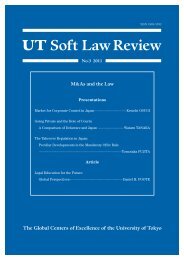UT Soft Law Review
UT Soft Law Review
UT Soft Law Review
Create successful ePaper yourself
Turn your PDF publications into a flip-book with our unique Google optimized e-Paper software.
<strong>UT</strong> <strong>Soft</strong> <strong>Law</strong> <strong>Review</strong> No.2 2010damage. That means the lawsuit is a gamble for the acquirer. Even if we regard the purpose ofthe defense plan, that is, obtaining enough information, as legitimate, I think it is implausiblefor the court in Japan to permit the defense measure which will give the acquirer suchdamage just because the acquirer failed to provide enough information. If so, it could bedifficult to implement the defense measure without financial compensation, even for thepurpose of obtaining the information.Now let me give one possible solution to this problem. Suppose the acquirer triggers theimplementation of the defense measure by buying the adopter’s shares beyond a certainthreshold or initiating TOBs without providing the information the board of the adopterrequired, since the acquirer believes that the board’s requirement is unreasonable. Then theboard will make a resolution to allot discriminative share options as a defense measure. Theboard can, however, make this resolution not final and binding but conditional, promisingthat, if the acquirer initiates the lawsuit to challenge its resolution, then the board willpostpone the allotment of share options as long as the suit is pending, and moreover, theboard will rescind its resolution if the acquirer “withdraws” immediately after the suit is over.For example, suppose the acquirer initiates the suit for injunction, but the court decides theallotment of share options is legitimate, probably because the board’s requirement to provideadditional information was reasonable in the circumstances. Then the acquirer can“withdraw.” “Withdraw” here means to withdraw the tender offer bid or, if the acquirertriggered the implementation of the defense measure by acquiring the adopter’s sharesbeyond a certain threshold (15% or 20%, as provided in the defense plan), it means for theacquirer to sell the shares within a certain period of time to reduce its shareholding below thethreshold. If the acquirer “withdraws” by either way, then the board of directors of theadopter will rescind the allotment of share options in accordance with the condition it madein the original resolution. In this scenario, the acquirer is given an opportunity to challengethe defense measure in court without taking a risk of suffering the loss by the allotment ofdiscriminative share options. In my opinion, giving the acquirer such an opportunity is animportant factor (perhaps necessary condition) for the court to rule the allotment ofdiscriminative share options without financial compensation as legitimate. If the board’sresolution to allot the discriminative share options without financial compensation is final andbinding, then the allotment will cause a significant harm to the acquirer. As I said before, it isimplausible fot the courts in Japan to permit such a defense measure. In contrast, if the boardmakes the resolution conditional in a sense I explained so far, then, I suppose, the probabilityfor the court to rule the defense measure as legitimate will fairly increase. In the latter case,the court may well feel that its decision that the defense measure is legitimate will not causethe acquirer inevitable damage, but just put the acquirer back to the original position andprohibit the acquirer from carrying out the acquisition.The fundamental problem here is that the Japanese system is not like American systemwhich allows the acquirer to file for the order to cancel the existing share options. But puttingthis aside, there should be a way for the defense measure to be regarded as legitimate evenwhen the financial compensation is not provided to the acquirer. Otherwise, takeover66





